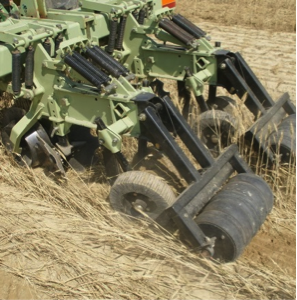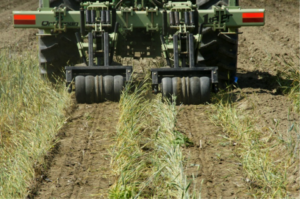Strip Till Management
go.ncsu.edu/readext?947198
en Español / em Português
El inglés es el idioma de control de esta página. En la medida en que haya algún conflicto entre la traducción al inglés y la traducción, el inglés prevalece.
Al hacer clic en el enlace de traducción se activa un servicio de traducción gratuito para convertir la página al español. Al igual que con cualquier traducción por Internet, la conversión no es sensible al contexto y puede que no traduzca el texto en su significado original. NC State Extension no garantiza la exactitud del texto traducido. Por favor, tenga en cuenta que algunas aplicaciones y/o servicios pueden no funcionar como se espera cuando se traducen.
Português
Inglês é o idioma de controle desta página. Na medida que haja algum conflito entre o texto original em Inglês e a tradução, o Inglês prevalece.
Ao clicar no link de tradução, um serviço gratuito de tradução será ativado para converter a página para o Português. Como em qualquer tradução pela internet, a conversão não é sensivel ao contexto e pode não ocorrer a tradução para o significado orginal. O serviço de Extensão da Carolina do Norte (NC State Extension) não garante a exatidão do texto traduzido. Por favor, observe que algumas funções ou serviços podem não funcionar como esperado após a tradução.
English
English is the controlling language of this page. To the extent there is any conflict between the English text and the translation, English controls.
Clicking on the translation link activates a free translation service to convert the page to Spanish. As with any Internet translation, the conversion is not context-sensitive and may not translate the text to its original meaning. NC State Extension does not guarantee the accuracy of the translated text. Please note that some applications and/or services may not function as expected when translated.
Collapse ▲Strip tillage management is a conservation tillage practice that encompasses all the benefits of no-till management, like more soil organic matter, improved water infiltration, reduced soil erosion, higher crop yields, and energy conservation, but in addition, it also helps in alleviating compaction and root growth problems. This post will take you through the benefits that strip-till management provides for improving your soil productivity in a sustainable manner.
Figure 1. Strip till in field example. Photo credit – Alan Meijer
Conservation tillage practices cause less soil disturbance and leave more residues on the soil surface in comparison to conventional tillage practices. Soil organic matter can increase when conservation tillage method like no-tillage is practiced in which the no-till planter/seed drill places the seeds along the crop row and leaves the soil between planting rows undisturbed. No-tillage, however, cannot alleviate compaction issues that are already existing in the soil. In soils where repeated intensive tillage practices have been carried out, there is a chance of compaction of the plow layer. Even though tillage can provide relief to compaction by loosening the soil, the problem with this approach is that this is temporary and intense tillage will further be required to offset the cloddiness problems caused in the plow layer. The soils under such tillage practices can get addicted to the temporary loosening, and converting abruptly to no-till can result in failure. In such cases, incorporating minimal tillage practice that promotes soil loosening by creating minor soil disturbance at the surface can be utilized for the slow transition from till to no-till management.
Strip tillage is a minimal tillage method and an enhanced version of no-till, in which, in addition to opening, placing seeds, and covering, some amount of soil loosening is also included. In strip tillage management, the soil is disturbed in strips only along the rows where future crops will be planted. This is achieved using narrow shanks (blades used to till the strips) that loosen the soil up to 6-8 inches depth along the crop row. Like any other tillage method, care should be taken to avoid field traffic during wet soil conditions to avoid plow layer and subsoil compaction. The depth to which the narrow shanks should cover depends on where the compaction problems exist- on the surface layer or subsoil. In cases with subsurface compaction, in row subsoiling can be done with strip tillage using deeper narrow shanks.
Compared to no-till, strip-till can be considered a good alternative in fine-textured soils that are more prone to compaction. Strip-till can also be effective in sandy soils of the coastal plain region where continuous no-till has increased soil bulk density to levels detrimental to root growth. When residues are left on the soil surface, there is a chance for increased disease pressure due to moisture retention near seedlings, and this can occur under no-till management. This problem can be reduced to an extent by using strip tillage by tilling the area along the crop row. Weed control can be accomplished with strip tillage if the herbicides are banded over the row. Otherwise, cover crops can still be incorporated into the crop rotation for weed control. In terms of nutrient management, strip tillage can help alleviate the nutrient stratification ( retention of nutrients in the upper few inches of soil) that can occur with continuous no-till management. But the effect can depend on the depth and width of the tillage and the fertilizer, lime application (broadcast, band placement) strategy being followed in your field.
Based on the soil condition and requirements, decisions can be made on the type of strip-till machinery needed. The width and shape of points attached to the shank can be altered to vary the extent and zone of soil loosening needed. Vertical shanks are better at causing the least soil disturbance, and the extent can be altered by adding an angle. The strip width of the strip-till unit can range from 6 inches to 12 inches, which can be chosen based on the extent of soil residue that is required for the field. In comparison to no-till, strip-till machinery attachments can cause more power requirements for the tractor.
Strip tillage is a viable option for farmers who want to make a slower transition from intensive tillage to no-till management. For further information regarding strip tillage, you can join our extension and education activities.
Please check for factsheets about conservation management practices that involve strip-till.




